The Heimbigners do their best to break their Phoenix Custom Camper and Ford F550 while testing a compost toilet, pushing their off-grid systems, and avoiding piranhas.

It’s probably safe to say that no one seeks out a compost toilet as their first choice. No one decides to give up the flush-it-and-forget-it luxury of modern household plumbing and choose to go on coconut husk instead. After all, coconuts make for delicious candy bars and interesting tribal swimwear, but why would anyone put them in a potty on purpose?
Then life presents an amazing opportunity. Travel the globe in a four-wheel drive truck with a fully-self-contained truck camper. You’ll have everything you need with you, but nothing more. Food, water, and life’s basics could be hard to come by, so you’ll need to use them sparingly. Do this, and you can see the world.
As you think this over, you look for new ways to conserve in every way possible. Water is your ultimate concern. Without it, your trip is immediately over. With it, and you can go further, for longer, and experience everything you’ve ever dreamed of. How can you save water?
That’s when you hear about this new compost toilet. It separates number one from number two. The number one can be disposed almost anywhere. Number two gets enmeshed with – yes – coconut husk! Here’s the best part; composting toilets use no water. Suddenly you can’t wait to go number two on coconut husk. Bring on the compost toilet!
Bruce and Laurie Heimbigner just read that introduction and thought, “That’s about right.” I know this because they’re (a) about to see the world, (b) in a truck camper, and (c) with a compost toilet that uses coconut husk (aka coconut coir fiber). Fortunately, the compost toilet is not the only interesting solution they’ve found for the multi-year world-wide adventure before them.
This article picks up from How To Build a World Ready Rig Part 1. For Part 2, the Heimbigners dive deeper into their incredible rig build, explore its capabilities and limitations, attempt to break it on the dirt roads of Utah and Mexico, and reveal the personal reasons for their multi-year continent-crossing itinerary. Tip 1: Look out for piranhas!
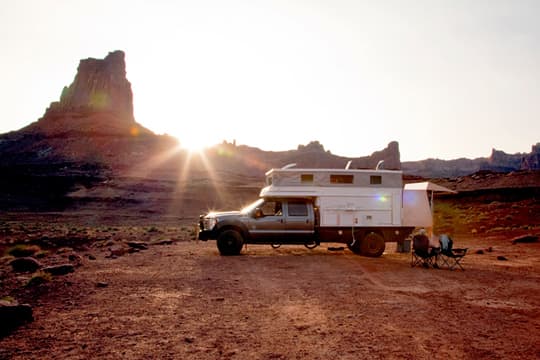
Above: First night on the White Rim Trail, Utah
TCM: Did either of you go tent camping or RVing when you were growing up?
Laurie: As kids both our families did a lot of camping in tents or small trailers and typically visited national parks or went fishing. As adults, we’ve always loved getting out in nature and away from the crowds. Before building this rig, we were primarily backpackers with occasional tent camping trips with the kids.
Bruce: For years I had the dream of sailing around the world. After the kids left home, we took sailing lessons and bought a small sailboat that we could camp out with. As we took sailing trips on bigger boats and explored farther from the coast, it became obvious that our opinions diverged about the sailing around the world. That spawned the discussion about how we would both enjoy traveling around the world.
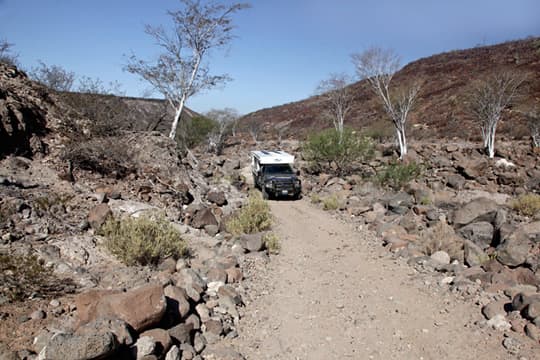
Above: South of San Ignacio, Baja
TCM: What is it that has you taking to the sea and wanting to travel the world?
Laurie: We both really enjoy being well off the beaten path, taking photographs, biking, kayaking, walking, and writing. Our travel goals right now probably sound a little crazy. We’re attempting to test our limits, and break anything that is going to break.
TCM: You’re trying to break your rig?
Laurie: Yes. Since we plan to leave the country in the next two years, we figure that we need to find out where our weak points are so we break them where we can still easily replace them with something sturdier. That way we’ll learn what kind of places we can safely take Livingstone and what kind of places we should avoid.
TCM: How are you preparing to leave the country?
Bruce: Once we leave North America, we will be trying to avoid taking chances. Our camper will be our home. We are not going to want it compromised or damaged. We will be cautious.
Laurie: A year ago I saw a picture on the internet of a family traveling across the world that impacted me. It was of a large overland vehicle in Mongolia. They were traveling on a hand built road in the mountains. The locals used hand-made bricks to make the roads, and the vehicle crumbled the road to the village and destroyed it.
We know that our rig is long and heavy. We want to be respectful of the people who are creating the roads. It only took a moment for that rig to demolish it. There will be situations in which we could go certain places, but should we? We don’t want to put ourselves in that kind of situation. We don’t know how it will play out, but that picture was a wakeup call.
TCM: The Tread Lightly campaign comes to mind. How do you learn where you can safely take your truck camper rig?
Bruce: We have taken the rig to Baja Mexico and Utah to travel dirt roads. In Baja we were stuck in one spot for twenty-four hours. We were on a steep mountain road and couldn’t go around a sharp corner due to a curved rock wall on the uphill side and a huge rock on the inside of the corner of the downhill side. I could have easily winched the rock, but it was the size of a small car, so that could have damaged the road and risked truck. I had to figure out how to swing the rear of truck sideways so we could clear it.
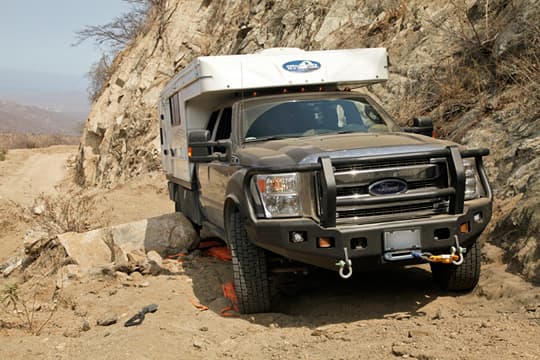
Above: The rock is in the way of the rig, so they’re stuck – front view
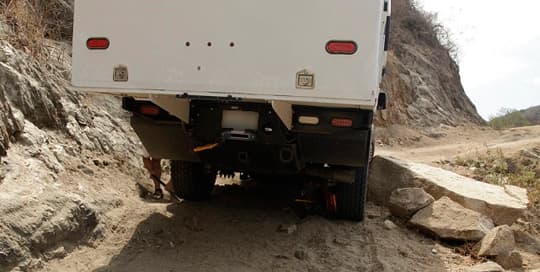
Above: The rock is in the way of the rig, so they’re stuck – back view
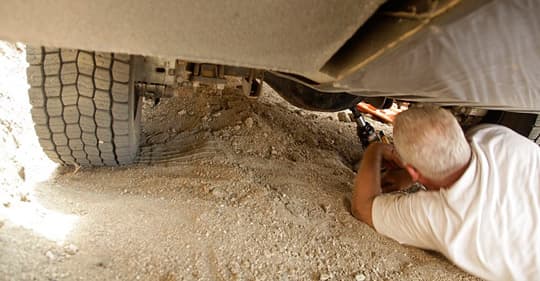
Above: Using the jack to move the truck a matter of inches
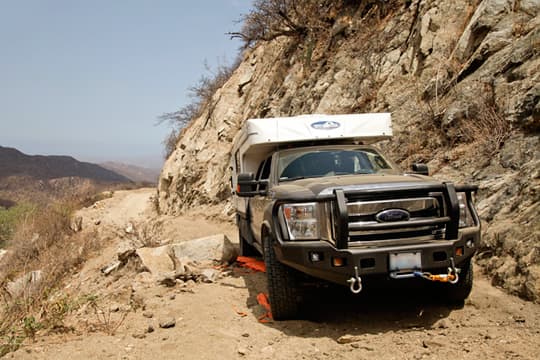
Above: After Bruce had jacked the rig around the rock
We ended up spending the night there. In the morning I got us lined up, placed the jack at an angle against the axle, and then pushed the rear of the truck sideways a foot and a half (a quarter of an inch at a time).
Laurie: He’s very clever. It’s also great that we have our motorcycle. We can scout ahead to see if it’s okay for us to take the rig, or not.
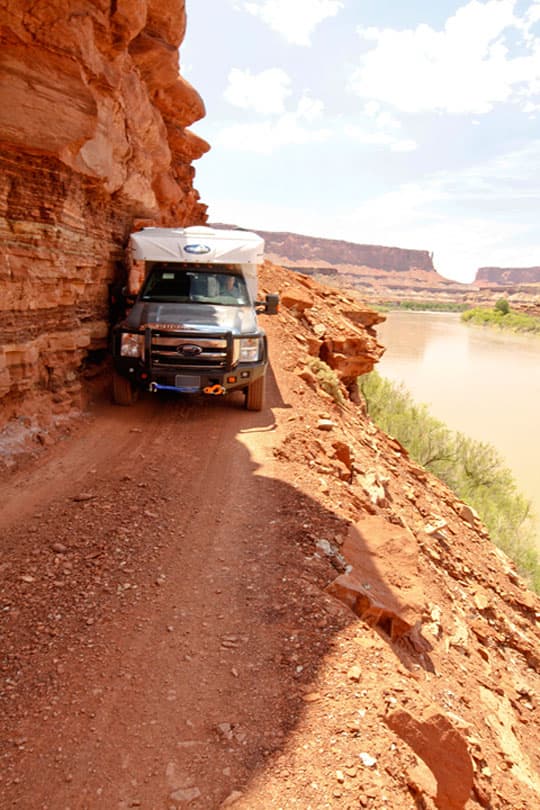
Above: The White Rim Trail, along the Green River, Utah
Bruce: We now have an idea of what we want to do, what we can do, and where we can go. We want to support the people where we’re visiting. We have contacts in almost every country in the world. We are going to evaluate local needs and determine whether we might be able to help.
Our service work has directly affected the design of the rig. For example, our garage and camper can come off our truck as well as a hitch for a trailer. We can use the truck to haul stuff for disaster relief or whatever need might come up.
Laurie: We’re both working on our Emergency First Responder, ham radio operator, and English as a second language certifications. That will help to keep us safe, and help others.
I am nurse and Bruce is a computer guy with an agricultural background. We both are experienced teachers. I will be working on the Livingstone Project. I love to write and take photos. In all of the different cultures and places we visit, I am going to ask people the same three questions. One question I am considering is, “If you could do anything, what would it be?” And I still need two more questions. I’ll also photograph him/her with something that is important to him/her. The answers and photos will go into a book sharing what’s important to different people and different cultures from all around the world.
TCM: How long will this trip be?
Laurie: We were thinking five to seven years, but it may take ten years. We’ll see. I have an agreement to come home twice a year because of our grandchildren. That was part of the family negotiations. We’ll retire in March of 2017 and then we’ll see how ready we are to leave.
Bruce: It will be 50-50 as far as helping out and exploring the countries we visit. We have the basic route of where we want to go.
Laurie: We also want to figure out what needs to be strengthened before we go, and how to get ourselves out of the trouble that we get ourselves into. So far we’ve been very successful in meeting that goal.
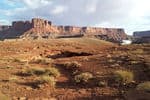 |
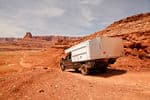 |
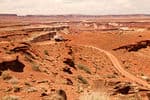 |
Above: The White Rim Trail, Utah – click to enlarge
TCM: Are there examples other than the rock you needed to get around?
Laurie: On our way to the Overland Expo in 2013, our inaugural voyage, we took a three day side trip on the White Rim Trail through Canyonlands National Park. The scenery was stunning, but the road was misnamed. “White Knuckle Road” describes it better.
We have taken many short trips to the mountains of eastern Washington and northern Idaho to relax, kayak, motorcycle, hike, and bike.
In June 2014 we drove to Baja for three weeks to further test our bad road readiness. That involved crossing the peninsula from sea to sea, not once but twice, using dirt and rock ranch roads, and the added twist of unreliable maps and a foreign language.
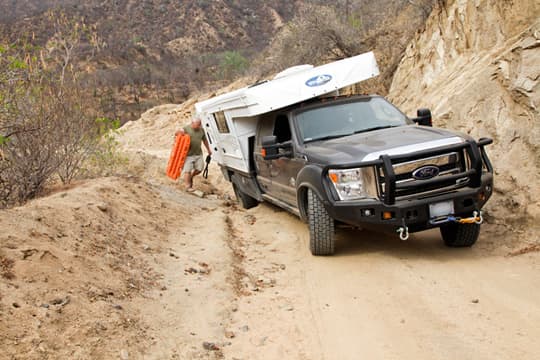
TCM: Any valuable lessons from that trip?
Bruce: Directions given by well-meaning people can be wrong. Very, very wrong.
If you start getting stuck, it’s better to stop and back out instead of trying to power forward.
Laurie: Maxtrax recovery devices are your friend! I’m probably the only woman who would want more Maxtrax for Mother’s day. You put one Maxtrax in front of the other to get out of sand, mud, lack of a road, or a wash out. We used Maxtrax a lot in Baja.
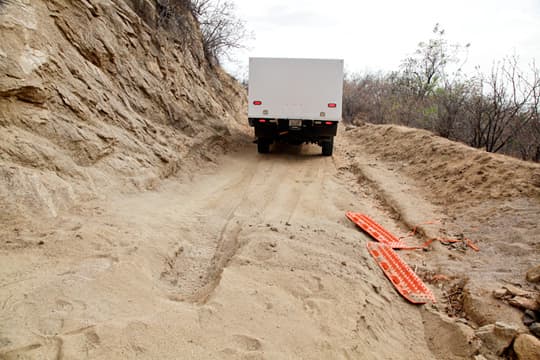
Sharp rocks hidden under the sand are a problem. We’ve named them “piranhas”. The truck has a lot of power and it’s heavy. When you combine those two things, and your tires are spinning, you might come across a rock that you don’t see, and it can damage the tires. I keep a sharp eye. I tell Bruce to slow down and to look carefully. If we see a piranha, we avoid it. We’re getting better at communicating.
Bruce: Our camper length and the sharpness of bends in the road need to be taken into very serious consideration when determining our route. Our rig is 19,000 pounds fully loaded and 27-feet long, which is pretty long for a camper. But the biggest problem is the 200-inch long wheel base. In Mexico, Thailand and Africa people are driving around in terrible pickups that are two wheel drive. Our rig is intended to go in places those trucks go. I call them old beater pickup roads which are a little worse than the commonly referred to market town roads.
It’s really important to double check that you latched all your latches before driving off.
If the ride is really bumpy for the driver and passenger, it’s getting ready to break or smash something somewhere in the truck, camper, or garage.
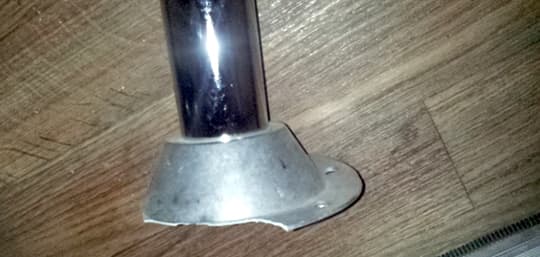
Above: The table mount broke on a bumpy road
This leads to our “Items broken and replaced” list: OEM running boards, table mount, refrigerator door, fridge mount, bed platform hinges, potable water hose (many leaks), compressed air line leaks.
All of these items broke in off-road situations. I’m very pleased with our Phoenix Camper. We have put ten to fifteen years of ordinary use into it in two years. We have taken two big trips and lots of little trips.
Being able to use the motorcycle to scout ahead is huge benefit especially since most people familiar with a four-wheel drive roads think of short narrow Jeeps and motorcycles, not big long trucks.
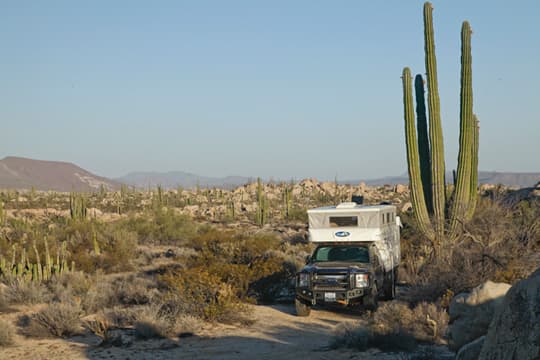
Above: Camping in Baja near Catavina
TCM: Where have you been with your truck camper that you would recommend to other truck campers?
Bruce: Baja is amazing, safe, and a boondocker’s dream. Popular beach camping locations during the winter high season cost around $10 a day. For the rest of the year, and for areas that are off the beaten track, many of the most beautiful locations with warm tropical water right outside your door are free.
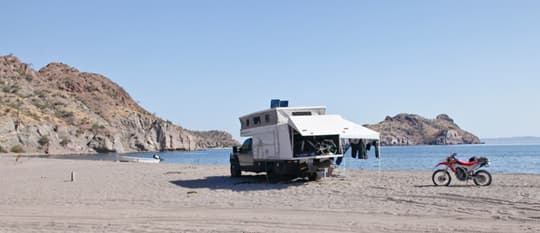
Above: Camping at Agua Verde Beach, Baja
TCM: That sounds incredible. Do you only dry camp with your camper?
Bruce: Almost exclusively. Besides beaches in Mexico, we generally look for BLM land, pull off the highway, drive a couple miles down a gravel road, find a wide spot, and set up in instant paradise!
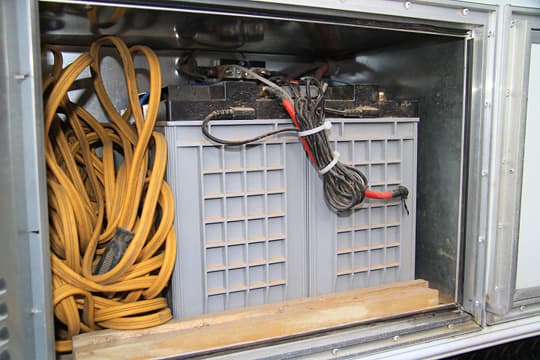
Above: They have Lifeline AGM batteries installed in their rig
Our plan when we go overseas is to be able to live off-the-grid for three weeks at a time. Besides the large batteries, the camper has solar panels, a gasoline generator, high output truck alternators, and an inverter.
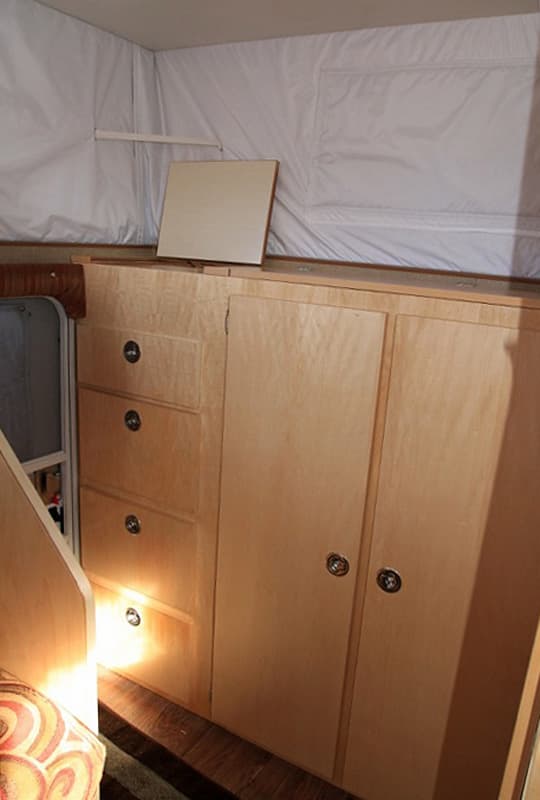
The entire back wall of the camper is storage. We can boondock until we run out of fuel, water, or food. If we have a fresh water source, even from a stream, we can stay out for a very long time.
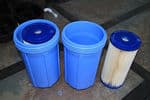 |
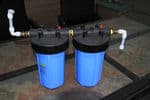 |
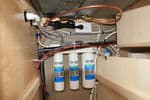 |
TCM: Tell us about your water purification system.
Bruce: We have a six step water purification system. Theoretically you can place the intake hose in any fresh water source no matter how contaminated and have safe drinking water come out of the tap. That said, you’re not going to want to use it with super polluted water, or salt water.
We have a long electrical cord, and a 12-volt water pump which also serves as a spare for the camper. We can pump water to the first two steps which are filters mounted in the side of the camper. Those pre-filters remove dirt, sand, and algae, and empty directly into the standard filler bib typical of campers and into the 100 gallon tank. Those two filters are cleanable.
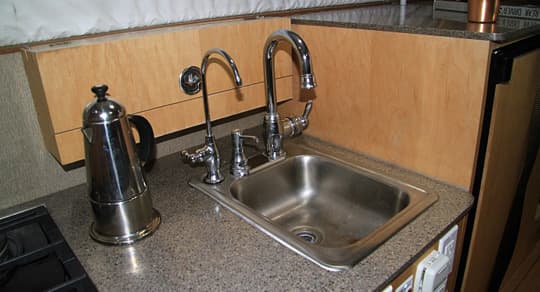
Above: Purified water and soap dispenser next to the regular faucet
At that point it is not potable, so we chlorinate it as a third step, which makes it shower and cooking safe. There are three more filtration stages that remove the chlorine, biological, and other chemical impurities before it becomes drinking water. We have a separate drinking water spigot. The final three filters are disposable.
Laurie: When it comes time to test, I will have some fresh water nearby for me and let Bruce try it first.
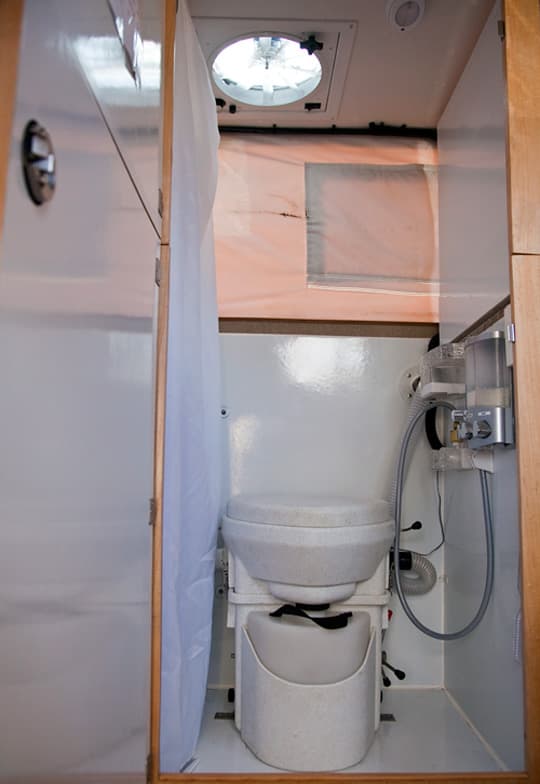
TCM: Good idea. Tell us about your composting toilet.
Bruce: The toilet is a Nature’s Head composting toilet. It separates liquid waste from solids. We empty the liquids about every two days, while the solids mix with shredded coconut fiber to break down into compost that can be safely buried about once per month.
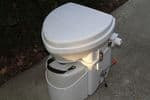 |
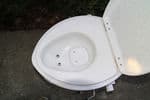 |
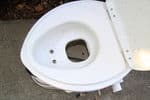 |
The primary benefit of the composting toilet is that it doesn’t use any water. We want to be in remote places and use as little water as possible – and there won’t be any dump stations. I don’t know where I came across the concept of a composting toilet, but I thought it was fantastic. I emailed a couple of people on Expedition Portal, and read reviews. There is a good explanation on Amazon’s reviews.
It might not be for everybody because dumping it is different than a regular RV toilet. There’s no black tank. It has a gross factor because the clean out is inside the camper not from the outside.
Urine can be dumped anywhere, it doesn’t spread disease, and doesn’t require composting. You can dump urine in a remote area. If you are camping where someone else might camp before the next rain, dig a hole and cover it, that’s what we do.
Laurie: The toilet holds two gallons of urine, which takes about two days to fill depending on how much you use it. The composting part is when you use toilet and there’s solid waste. You mix your waste with the shredded coconut husk by turning a knob on the side.
Solid waste today is not dirt tomorrow. It’s still human waste. It’s a bio-hazard, so you have to put it in a real toilet or bury it. The solid waste has the texture of damp compost and is in the bottom section of the toilet. You have to remove the toilet and dump it out. Some people may not like it. A cassette toilet stays outside camper, but our composting toilet is inside. You clean it by taking the toilet out and dumping the solid waste.
We have been out on three week trips and haven’t had to dump the solid waste, so it lasts a long time and we haven’t had to worry about it. It has a 12-volt fan that pulls the exhaust outside so the bathroom doesn’t stink. Even without the fan, it smells somewhat earthy. You can also use sawdust on the solid side instead of coconut fiber. Anything with cellulose will work.
Bruce: We think it’s a great choice. That was one of the things that we changed in the design after it was built. Robby was building the camper and we changed our mind when it was almost done.
TCM: I know a few readers are thinking, “That’s really neat” while others are thinking, “No way.” We get the same reaction when we talk about cassette toilet systems. Does anyone travel with you?
Bruce: So far we haven’t found anyone crazy enough, but we do have room for five in the cab and a 12’x12’ shelter/tent for guests, or us. The camper sleeps two comfortably, or four if two people are very friendly.
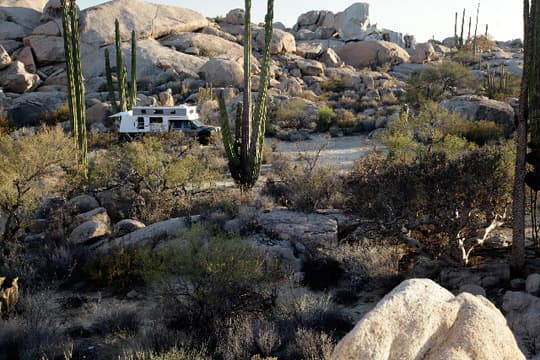
Above: Camping in Baja near Catavina
TCM: You have assembled a fascinating and unique rig for a fascinating and unique purpose. Is there anything else you would like to add?
Laurie: We’re continuing to discuss route options for our world trip. A lot will depend on what is happening on the political front as we enter each region of the planet, and what transoceanic shipping ports are most cost effective.
We want to drive through Mexico, Central America, Australia, Asia, India, and Africa. But then New Zealand, South America, and Europe sound too good to miss as well.
Bruce: I’m a remodeler, so I have a lot of plans for improvements before we leave North America – we’ll have to put up with any shortcomings for a long time.
TCM: We’d love to follow up with you during your trip. Please keep in touch as you travel overseas.
Laurie: We will!
Rig Information
Truck: 2013 Ford F-550, Lariat, Crew Cab, Long Bed, Dual Rear Wheel to Single Rear Wheel, 4×4, Diesel
Camper: 2013 Phoenix pop-up, all custom
Tie-Downs and Turnbuckles: Direct bolt to bed’s frame
Suspension: Air Lift – Air boost springs front and rear, Hellwig sway bars front and rear
